Great blue herons (Ardea herodias) can be distinguished by their elegant silhouettes, beautiful blue-gray plumage, and impressive wingspans of up to 7 feet wide. They are spread throughout the Americas, especially North America, and are also found in the Galapagos Islands. Blue herons nest in large colonies called heronries of up to 400 nests. They may also nest in small heronries of breeding pairs or entirely alone. Although they do link up to mate, breed, and sometimes nest and hunt, these are pretty solitary birds. So, what do blue herons eat? Let’s find out how these majestic social misfits get a meal.
What Foods do Blue Herons Eat?
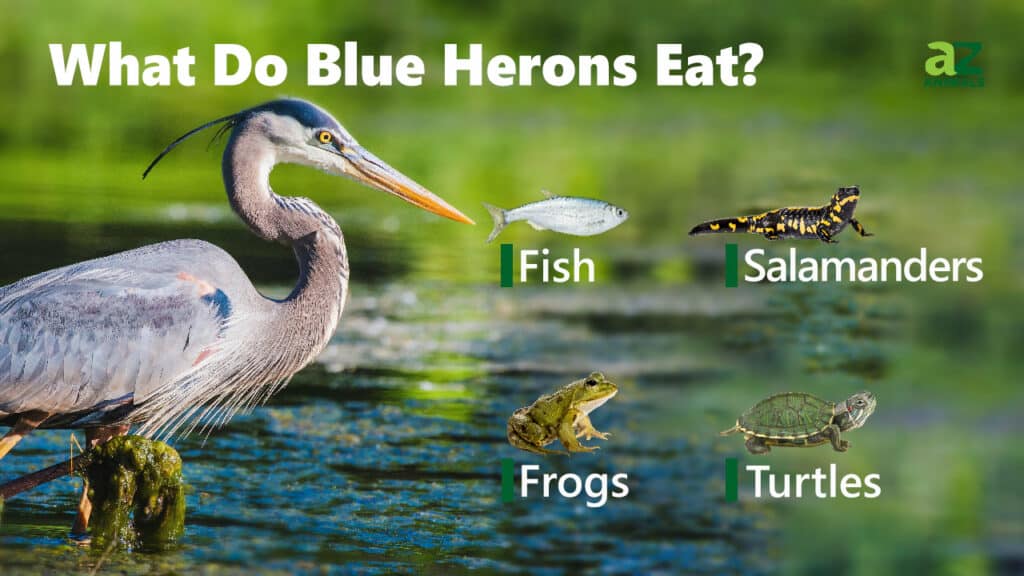
Blue herons primarily eat fish, small mammals, amphibians, reptiles, and insects. They are carnivorous wading water birds that consume other animals.
In addition to their primary prey, blue herons on the coast will eat crustaceans and hatchling sea turtles. When upland and especially in the winter, they will eat small mammals like squirrels, chipmunks, cottontail rabbits, and voles. At times, they will eat small birds like blackbirds, starlings, and swallows along with their eggs. Live prey are preferred by these long-necked, long-legged predators and they will eat almost any animal they come across that is small enough to fit down their long and slender throat.
Blue Herons Favorite Meal
As aquatic wading birds, it comes as no surprise that the mainstay of blue herons’ meals is fish. This is especially true in the summer months when they can enjoy a wide range of fish species such as:
- Bass
- Goldfish
- Carp
- Perch
- Minnow
- Flounders
- Sticklebacks
- Gunnels
- Sculpin
- Salmon
- Top Smelt
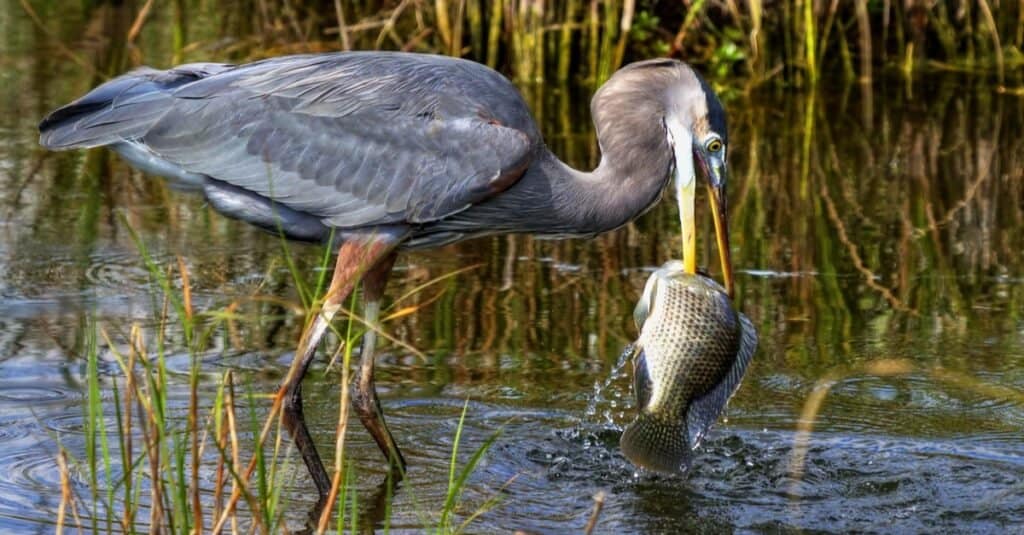
Fish make up the majority of the blue herons diet
©David Byron Keener/Shutterstock.com
In a population of great blue heron whose feeding habits were studied, fish were found to make up 44% of their prey but comprised 88% of the mass of their diet. So, while they’ll take advantage of any meal that comes their way, they do get the bulk of their food from finned swimmers. They even have specialized chest feathers that are helpful for removing fish slime and other oils as they preen. These feathers continually grow out and fray to a powder, which the great blue heron combs down with a fringed claw on their middle toes, using the down like a washcloth to clean up after a messy meal.
A Complete List of 15 Foods the Blue Heron Eats
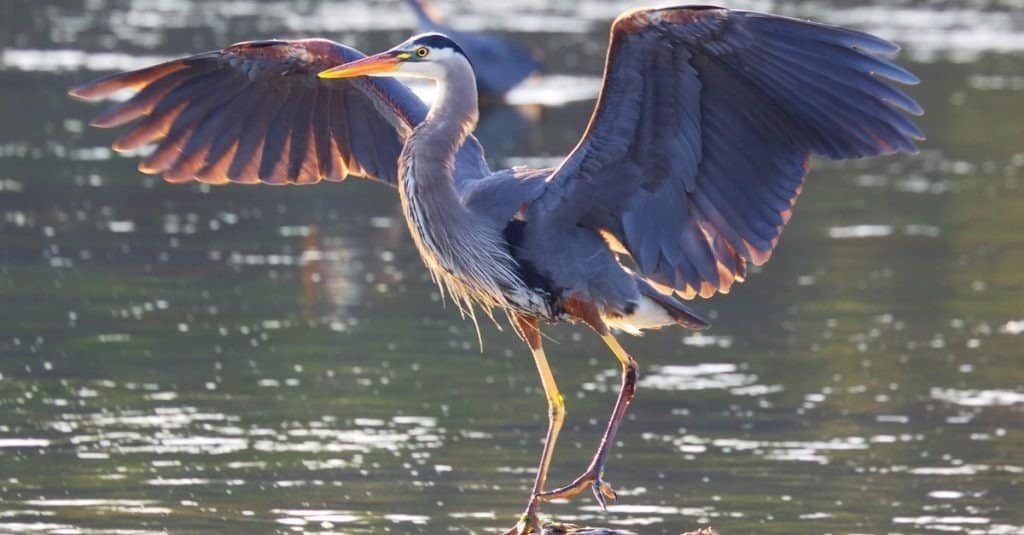
88% the mass of a great blue heron’s diet comes from fish, but they eat a number of foods.
©VDV/Shutterstock.com
Here are 15 foods that form the majority of the blue heron’s diet:
- Fish
- Salamanders
- Lizards
- Iguanas
- Insects
- Worms
- Crustaceans
- Mollusks
- Sea turtles
- Squirrels
- Chipmunks
- Cottontail rabbits
- Small birds & eggs
- Snakes
- Voles
Blue Heron Feeding Grounds
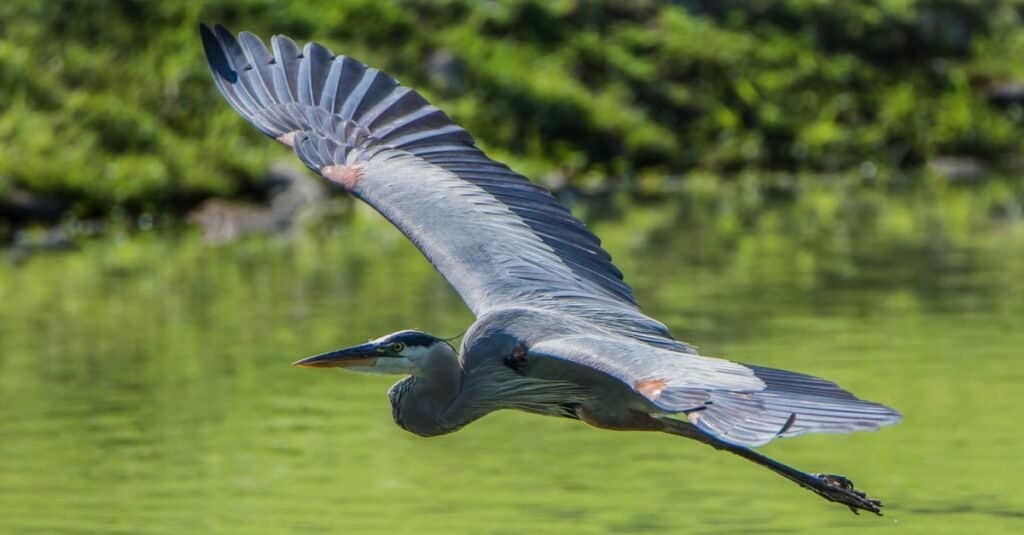
Blue herons forage along shorelines, marshes, ponds, fields, rivers and wetlands
©Tom Franks/Shutterstock.com
They forage for food along lakeshores, marshes, ponds, creeks, slow-moving rivers, grassy fields, and wetlands. Blue herons can be found in coastal freshwater and saltwater environments in bays, lagoons, inlets, coves, eelgrass, mudflats, marshes, and along beaches.
Herons are tree-nesters that make their home in a variety of different trees, depending on what’s available. A study of heronries along the Pacific coast of British Columbia found that a colony of blue heron nests serves as an information center that helps the birds to find food. Herons left the heronry in groups to forage different sites each day. This study found that herons feeding in groups caught fish more quickly and efficiently than solitary herons. While this may be the case in some habitats, herons typically have success as solo hunters. They are more solitary during the fall and winter months and live in colonies during the spring and summer. This provides protection during breeding months and allows each bird to have its own territory during the colder part of the year when prey are less abundant.
Hunting Habits of the Blue Heron
Impeccable night vision allows blue herons to hunt both day and night. They will stalk their prey by walking slowly, wading in shallow water. Occasionally they’ll flick their wings out and back repeatedly, making shadows that cause fish to panic and flee, becoming more visible. Blue herons are patient predators often standing very still waiting for prey to swim or scurry by close enough for capture. They may stand on one leg for long periods of time, making them appear more like a stick than a feared predator.
When hunting in aquatic areas, they are very adaptable and skilled with a range of methods. They will sometimes take advantage of floating objects and perch on them while they search below. They’ll dive for prey underwater both head-first and feet-first. Blue herons locate their prey by sight and catch them with a quick thrust of their neck. Their necks coil back into an S-shape and spring forward like a harpoon, snatching prey with precision.
What Do Blue Heron Chicks Eat
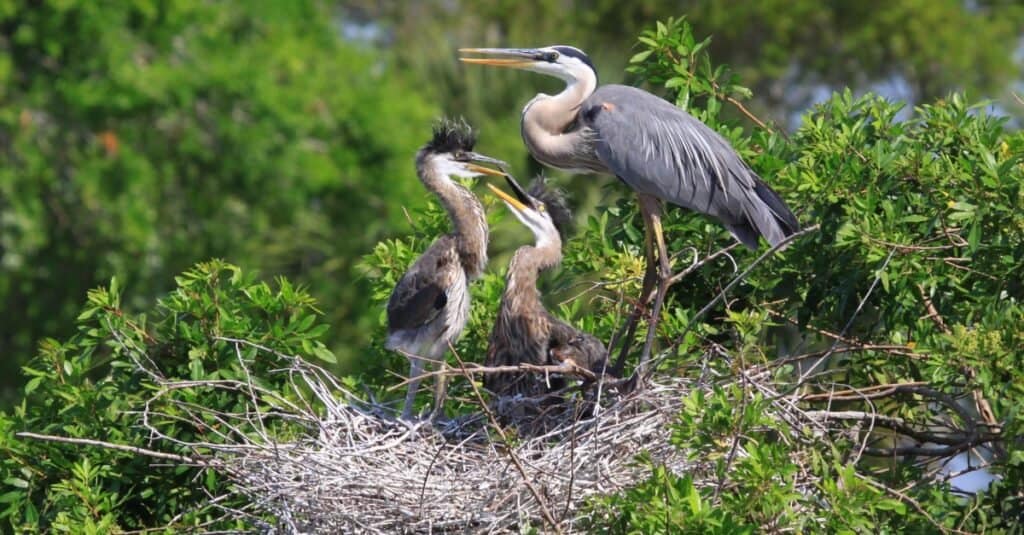
Impeccable eyesight helps blue herons hunt effectively
©Wolf Mountain Images/Shutterstock.com
Blue heron chicks leave the nest 8-10 weeks after they hatch. After developing their flight feathers, chicks will join adults on the journey to and from feeding grounds. After their first long flight, they will typically return to the nest and be fed by the adults for about 2-3 weeks. Heron parents feed their young about 4 times during daylight hours and may bring food to them once or twice during the night. Chicks eat the same diet as the adults only in another form. The parents regurgitate food from their bills into the nest and the chicks pick it up and gulp it down.
Who Eats the Blue Heron
The primary predator of the blue heron is the bald eagle. Black bears have also been found to capture and eat blue herons. Some colonies will change nest sites often and this is likely due to attacks by predators in the area. Young chicks and eggs in the nest are especially vulnerable to attack and can become food for ravens, golden eagles, great-horned owls, red-tailed hawks and racoons.Young chicks and eggs in the nest are especially vulnerable to attack and can become food for ravens, golden eagles, great-horned owls, red-tailed hawks and racoons.
Interestingly, a study on great blue herons in the Pacific Northwest showed that nesting behavior has been adapted so that they will often nest nearby breeding eagles. Since breeding eagles actively repel other eagles around the nest site, the area is a relatively safe place for blue herons to nest. The study showed that 70% of heron nests and 19% of heronries were located within 200 m of eagle nests. Gaining protection from the territorial behavior of the eagles, these herons had more success than those that nested far away from eagle nests.
The photo featured at the top of this post is © David Byron Keener/Shutterstock.com
Thank you for reading! Have some feedback for us? Contact the AZ Animals editorial team.






